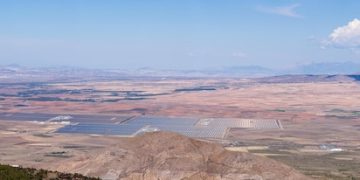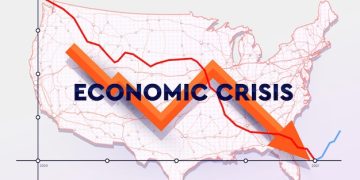Rising Energy Prices in 2025: Impact on US Businesses & Consumers

Analyzing the impact of rising energy prices on US businesses and consumers in 2025 reveals potential increases in operational costs for businesses and strains on household budgets, necessitating strategic adaptations and policy interventions to mitigate adverse economic effects.
The impending rise in energy prices in 2025 looms large, casting a shadow over both businesses and consumers across the United States. Analyzing the impact of rising energy prices on US businesses and consumers in 2025 requires a comprehensive understanding of the intricate web of economic factors at play, and proactive strategies to mitigate potential adverse effects.
Understanding the Energy Price Landscape in the US
The energy sector is a cornerstone of the US economy, influencing everything from manufacturing and transportation to household budgets. Fluctuations in energy prices have far-reaching impacts, and understanding the current landscape is crucial for businesses and consumers alike.
Factors Influencing Energy Prices
Multiple factors contribute to the volatility of energy prices in the United States. These include global supply and demand dynamics, geopolitical events, and domestic production levels.
- Geopolitical Instability: Conflicts and political tensions in energy-producing regions can disrupt supply chains and drive up prices.
- Economic Growth: Increased economic activity often leads to higher energy demand, putting upward pressure on prices.
- Environmental Regulations: Policies aimed at reducing carbon emissions can impact the cost of energy production.
Additionally, seasonal variations in demand play a significant role. For instance, demand for natural gas and electricity typically surges during the winter months for heating and in the summer for cooling, impacting prices.

Historical Trends and Future Projections
Analyzing historical energy price trends provides valuable insights into potential future scenarios. Over the past decade, energy prices have experienced significant fluctuations, influenced by economic cycles, technological advancements, and policy changes.
Various forecasting models project a potential rise in energy prices in 2025, driven by factors such as increased global demand and potential supply constraints. However, these projections are subject to uncertainty and depend on a variety of variables.
In conclusion, understanding the complex interplay of factors influencing energy prices is essential for businesses and consumers to make informed decisions and prepare for potential changes in the energy landscape.
Impact on US Businesses
Rising energy prices can significantly impact the operational costs and profitability of US businesses across various sectors. Businesses reliant on energy-intensive processes, such as manufacturing, transportation, and agriculture, are particularly vulnerable.
Increased Operational Costs
One of the most direct impacts of rising energy prices on businesses is an increase in operational costs. Higher energy bills can erode profit margins and make it more challenging for businesses to remain competitive.
For example, manufacturers may face increased costs for powering their production facilities, while transportation companies could see their fuel expenses rise significantly. These additional costs can ultimately be passed on to consumers in the form of higher prices.
Supply Chain Disruptions
Rising energy prices can also lead to supply chain disruptions, as transportation costs increase and suppliers face their own energy-related challenges. This can result in delays, shortages, and higher prices for raw materials and components.
- Transportation Costs: Higher fuel costs can make it more expensive to transport goods, impacting logistics and distribution networks.
- Supplier Challenges: Suppliers facing higher energy costs may struggle to maintain production levels or offer competitive prices.
- Inventory Management: Businesses may need to adjust their inventory management strategies to account for potential supply chain disruptions.
Strategies for Mitigation
Businesses can implement various strategies to mitigate the impact of rising energy prices. These include improving energy efficiency, investing in renewable energy sources, and hedging against price volatility.
Energy audits can help businesses identify areas where they can reduce energy consumption. Investments in energy-efficient equipment and technologies can also yield long-term cost savings. Furthermore, exploring renewable energy options, such as solar or wind power, can provide a more stable and predictable energy supply.

In summary, US businesses face significant challenges from rising energy prices, but with proactive planning and strategic investments in energy efficiency and renewable energy, they can mitigate these impacts and maintain their competitiveness.
Impact on US Consumers
Rising energy prices have a direct and often immediate impact on household budgets, affecting everything from utility bills to transportation costs. For many American families, these increases can create significant financial strain.
Household Budget Strain
One of the primary ways rising energy prices affect consumers is through higher household expenses. Increased costs for electricity, heating, and transportation can squeeze household budgets, leaving less disposable income for other essential needs.
Low-income households are particularly vulnerable, as they often spend a larger proportion of their income on energy. This can lead to difficult choices between paying for energy bills, food, or healthcare.
Transportation Costs
Higher gasoline prices also affect consumers, making it more expensive to commute to work, run errands, and travel. This can impact where people choose to live, how they commute, and even their leisure activities.
Consumers may respond by reducing their driving, carpooling, or switching to more fuel-efficient vehicles. However, these adjustments can be challenging for those who rely on their cars for work or have limited access to public transportation.
Mitigation Strategies for Consumers
Consumers can take several steps to mitigate the impact of rising energy prices. These include improving energy efficiency at home, making smart transportation choices, and taking advantage of government assistance programs.
- Energy Efficiency: Simple measures like sealing windows and doors, using energy-efficient appliances, and adjusting thermostat settings can help reduce energy consumption.
- Transportation Choices: Consider carpooling, public transportation, biking, or walking to reduce gasoline consumption.
- Government Assistance: Explore programs like the Low Income Home Energy Assistance Program (LIHEAP) to help with energy bills.
Additionally, consumers can explore options like switching to a fixed-rate energy plan or investing in energy-saving technologies to reduce their long-term energy costs.
In conclusion, rising energy prices pose a significant challenge to US consumers, but by implementing energy-saving measures and exploring available resources, they can manage their energy expenses and alleviate some of the financial strain.
Policy Implications and Government Interventions
Government policies and interventions play a crucial role in shaping the energy landscape and mitigating the impact of rising energy prices. These policies can range from energy subsidies and regulations to investments in renewable energy and infrastructure.
Energy Subsidies and Regulations
Energy subsidies can help lower the cost of energy for consumers and businesses, providing relief from rising prices. However, these subsidies can also distort markets and discourage energy efficiency.
Regulations, such as energy efficiency standards for appliances and buildings, can help reduce energy consumption and lower overall energy costs. These regulations can also promote innovation and the adoption of energy-saving technologies.
Renewable Energy Investments
Government investments in renewable energy sources, such as solar, wind, and geothermal, can help diversify the energy supply and reduce dependence on fossil fuels. These investments can also create jobs and stimulate economic growth.
Incentives for renewable energy, such as tax credits and grants, can encourage businesses and consumers to adopt renewable energy technologies. These incentives can also help lower the cost of renewable energy, making it more competitive with fossil fuels.
Long-Term Energy Strategy
Developing a comprehensive long-term energy strategy is essential for ensuring a stable and affordable energy supply. This strategy should address issues such as energy security, climate change, and economic competitiveness.
Such a strategy involves promoting energy efficiency, investing in renewable energy, and developing new energy technologies. International cooperation and collaboration is also essential for addressing global energy challenges.
In summary, government policies and interventions are crucial for mitigating the impact of rising energy prices and ensuring a sustainable and affordable energy future for the United States.
Technological Innovations in Energy Efficiency
Technological innovations are transforming the energy landscape, offering new and improved ways to reduce energy consumption and mitigate the impact of rising energy prices. These innovations span various sectors, from renewable energy to energy storage and smart grids.
Renewable Energy Technologies
Advancements in renewable energy technologies, such as solar panels and wind turbines, are making renewable energy more efficient and affordable. These advancements are also improving the reliability and scalability of renewable energy systems.
- Solar Panels: New solar panel designs are increasing energy conversion efficiency, allowing for more electricity generation per unit area.
- Wind Turbines: Larger and more efficient wind turbines are capturing more wind energy, reducing the cost of wind power.
- Energy Storage: Battery storage systems are becoming increasingly affordable, enabling the storage of renewable energy for later use.
Smart Grids and Energy Management
Smart grids are revolutionizing the way energy is distributed and managed, enabling more efficient use of energy resources and reducing waste. These grids use advanced sensors, controls, and communication technologies to optimize energy flow.
Smart meters provide real-time data on energy consumption, allowing consumers to track their usage and make informed decisions about energy management. Smart thermostats optimize heating and cooling settings based on occupancy and weather conditions.
Energy-Efficient Buildings and Appliances
Innovations in building materials and appliances are reducing energy consumption in homes and businesses. Energy-efficient windows, insulation, and lighting systems are minimizing heat loss and energy waste.
Energy Star-certified appliances meet strict energy efficiency standards, consuming less energy than conventional appliances. These appliances can save consumers money on their energy bills and reduce their carbon footprint.
In conclusion, technological innovations are playing a vital role in mitigating the impact of rising energy prices by improving energy efficiency, promoting renewable energy, and enabling smarter energy management.
Preparing for the Future: Strategies for Resilience
As energy prices continue to fluctuate and potentially rise in the coming years, building resilience is essential for both businesses and consumers. This resilience involves adopting proactive strategies to manage energy costs, diversify energy sources, and prepare for potential disruptions.
Energy Audits and Efficiency Improvements
Conducting energy audits is a crucial first step in identifying areas where energy consumption can be reduced. These audits can reveal inefficiencies in buildings, processes, and equipment.
Based on the audit findings, businesses and consumers can implement energy efficiency improvements, such as upgrading to energy-efficient lighting, sealing windows and doors, and investing in energy-efficient appliances.
Diversifying Energy Sources
Diversifying energy sources can reduce dependence on a single energy source and mitigate the impact of price volatility. This diversification can involve exploring renewable energy options, such as solar, wind, and geothermal, as well as investing in energy storage systems.
Businesses can also consider entering into long-term energy contracts or hedging against price volatility to secure a more stable and predictable energy supply.
Financial Planning and Budgeting
Effective financial planning and budgeting are essential for managing the impact of rising energy prices. Businesses and consumers should factor in potential energy cost increases when developing their budgets and financial plans.
Consumers can also explore options like energy assistance programs, budget billing plans, and energy-saving incentives to help manage their energy expenses.
In summary, building resilience in the face of rising energy prices requires a proactive and multi-faceted approach that includes energy audits, efficiency improvements, energy source diversification, and effective financial planning.
| Key Point | Brief Description |
|---|---|
| 💡 Energy Efficiency | Improving efficiency reduces consumption and costs. |
| 💰 Household Budgets | Rising prices strain budgets, impacting disposable income. |
| 📈 Business Costs | Operations and supply chains affected by higher energy costs. |
| 🌱 Renewable Energy | Investing in renewable sources can mitigate price volatility. |
FAQ Section
▼
Rising energy prices are expected to increase operational costs for businesses, particularly those reliant on energy-intensive processes. This could impact profitability and competitiveness.
▼
Consumers can improve energy efficiency at home, make smarter transportation choices, and explore government assistance programs like LIHEAP to manage their energy expenses.
▼
Government policies, such as energy subsidies, regulations, and investments in renewable energy, can help mitigate the impact of rising energy prices and ensure a stable energy supply.
▼
Technological innovations in renewable energy, smart grids, and energy-efficient buildings and appliances are helping to reduce energy consumption and lower costs.
▼
Businesses can conduct energy audits, implement efficiency improvements, diversify energy sources, and engage in financial planning to build resilience against rising energy costs.
Conclusion
Analyzing the impact of rising energy prices on US businesses and consumers in 2025 reveals both significant challenges and opportunities for strategic adaptation. By embracing energy efficiency, diversifying energy sources, and leveraging technological innovations, stakeholders can mitigate the adverse effects and build a more sustainable and resilient energy future.





